This was published 4 years ago
Traveller writers reveal the meals that changed their life
By Various writers
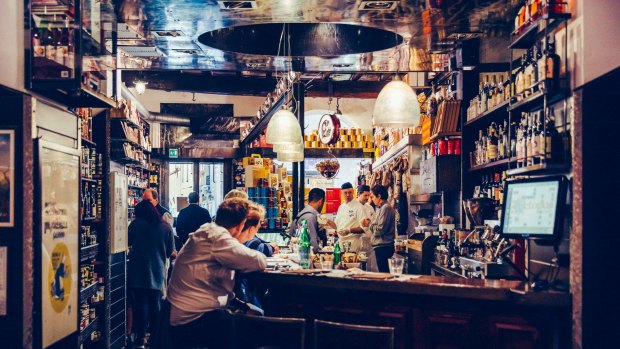
Sit among fridge cabinets and wine shelves at Salumeria Roscioli.Credit: Maurizio Camagna
One bite, and everything changes. One mere morsel of food. One tiny portion of a meal, and all of a sudden your world is turned upside down, your idea of what is good and bad, your opinion of what is delicious and what is inedible, your entire notion of life and what it can be – everything changes.
This is the beauty of food and the glory of travelling to enjoy it. Food is transformative. It's alchemical. It should be something so simple, the combination of a few products and ingredients handed to you on a plate, and yet it's so much more than that. It's such a vital display of identity, such an important representation of culture, of history, of passion and of skill.
So many of us can track our travels by the dishes we've eaten and the places in which they were consumed. Food becomes memory so cherished and real: that first crackle of a French baguette smothered in demi-sel butter; that first sip of broth from a bowl of Saigon pho; that salty, fatty, cheesy slip of pasta at a Roman trattoria. Spectacular experiences. Otherworldly joys.
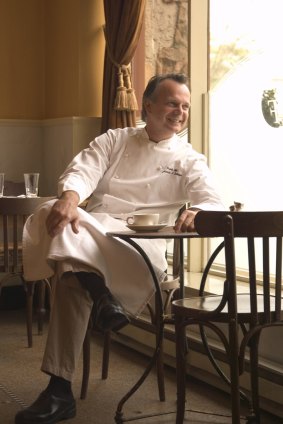
Chef Frank Stitt at the Highlands Bar and Grill in Birmingham, Alabama.Credit: Highlands Bar and Grill
Food, when you travel, can be so many things to so many people. It can be disappointing, of course. It can be challenging. It can even be disgusting. But then it can be tasty. It can be fulfilling. It can be mind-boggling. And on occasion – on a beautiful, memorable, rare occasion – it can be life-changing.
These are the meals and the moments that the Traveller team is celebrating today: the times when food has surpassed its function as mere sustenance or even as experience and caused our writers to rethink everything they know, to see not just cuisine but the world as a whole in a different light. For some that has been the product of a deceptively simple meal; for others it's been a journey to modern gastronomy's outer limits. What links those experiences is the shock, the wonder, the revelation. One bite, one morsel, one meal – and everything changes.
– Ben Groundwater
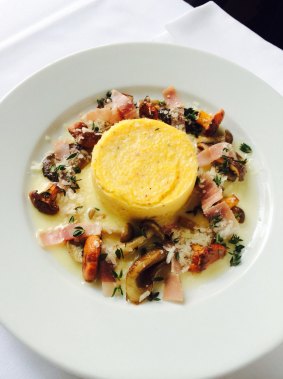
Stone-ground baked grits at the Highlands Bar and Grill, Birmingham, Alabama.Credit: Highlands Bar and Grill
TERRY DURACK
Dinner among the food shelves at Roscioli in Rome
When in Rome, I tend to do as the Romans do. I go to Roscioli for spaghetti alla carbonara, the most Roman of pasta dishes, in the most Roman of restaurants. Except it isn't really a restaurant, and that's what changed me.
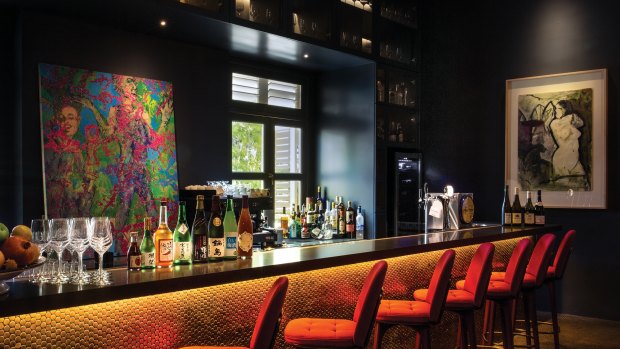
The bar at Coriander Leaf.Credit: Coriander Leaf
Roscioli has always reinvented itself, beginning as a traditional Roman bakery opened by Marco Roscioli in 1972, at the suggestion of his entrepreneurial uncle, Franco. The Antico Forno Roscioli in via dei Chiavari was built on the site of a bakery dating back to 1824, and the tiny store grew and grew, as if powered by yeast. By 1993, Roscioli also opened a salumeria and grocery store nearby that sourced the finest produce from all over Italy.
It didn't take long for local shoppers to beg for some of the mortadella or provolone to be sliced and stuffed into a panini, and maybe for a glass of wine to go with it. In 2002, Marco's sons, Pierluigi and Alessandro, added a tiny basement kitchen and wine cellar to the deli, and squeezed a few small tables and chairs into the shop. A new Roman tradition was born.
I was walking past one fine day soon after, and stopped to peer in to this magical place, its walls lined with giant tins of salted anchovies, whole wheels of Parmigiano Reggiano and dozens of bottles of fine Italian wine, with tables taking almost all the available space. My laughable Italian got me a table for dinner, squeezed up against the refrigerated glass deli counter under hanging legs of prosciutto di San Daniele. It changed the game for me.

The Nishimuraya Honkan in Kinosaki, Japan.
Why? The carbonara. It was chewy, resilient, challenging. It was salty, rich and peppery. I've had good pasta before. I've even had great pasta. But this really felt like I was eating Rome. The spaghettoni (like thick spaghetti) was coated in an emulsion of sizzled guanciale (pork jowl) fat, aged pecorino and the yolks of rich, golden eggs from celebrated poultry producer, Paolo Parisi, under a shower of freshly ground Sarawak pepper. The flavour came in waves, and the al dente nature of the pasta forced me to slow down, chew every mouthful, take my time. It's probably the first time I ever really understood the principles of the slow food movement.
That pasta became an instant benchmark against which all other pasta has been measured. It helped me understand that magic happens when tradition is not considered sacrosanct but built upon – respected and yet updated, like Rome itself. I am forever looking forward to going back to Roscioli to relive the moment. See salumeriaroscioli.com
BEN GROUNDWATER
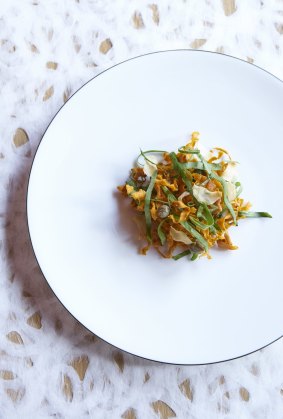
Cosa Croccante is a clever update of a traditional carrot salad.
Live baby eel at Mugaritz, Spain
It's a trick. There's no way this is what we think it is. They've used some sort of gel, I tell my partner, to make the eel look as if it's still moving. It's meant to play with our perceptions. It's supposed to mess with our minds.
The dish is placed in front of us with no comment or explanation. It isn't even a dish, in fact, just a folded napkin upon which sits a perfect sphere of clear liquid, a bubble twice the size of a 50-cent piece. Inside that bubble is a single elver, a baby eel, a delicacy here in the Basque Country when it's sauteed with olive oil and garlic. But this one seems to be moving.
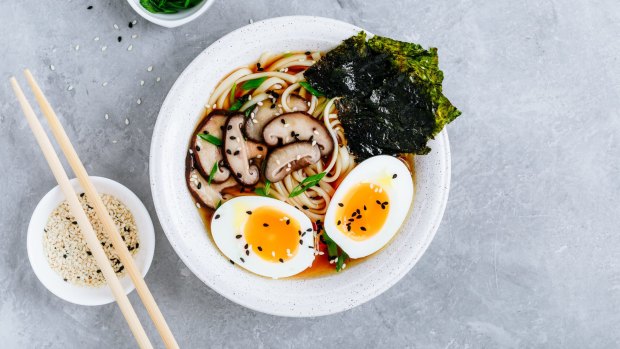
Asian vegetarian noodles soup with shiitake mushrooms.
My partner spies a waiter hovering nearby. "Is this alive?"
He just nods a "Yes." We let that news settle over us as we stare at our "plates". The eel inside is alive. We're expected to eat it. Now.
The restaurant is Mugaritz, an avant-garde eatery in the mountains above San Sebastian. Its chef, Andoni Luis Aduriz, is known for pushing boundaries, for leading his diners on thrilling journeys through texture, aroma and taste.
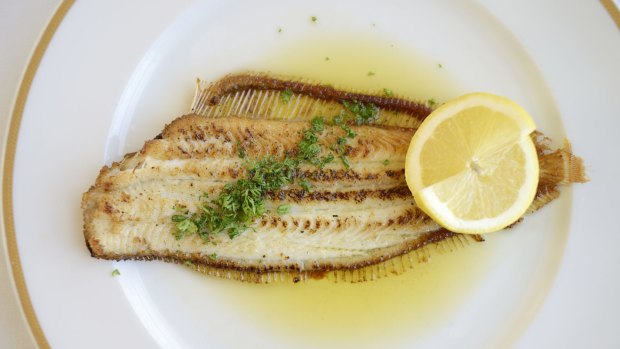
A delicious serving of locally caught Sole Meuniere with fresh lemon.Credit: iStock
This is not supposed to be just another delicious meal. You can have one of those anywhere in the Basque Country. Food at Mugaritz is adventure and experience, it's gastronomy in all its glory, experimental and esoteric and wild. It challenges you. It tests you. And there's nothing as testing as the live baby eel encased in seawater. We find out later that the dish is simply called "Origins". No kidding. It looks like the very beginning of every life. It is a life. It is alive.
This is Aduriz talking to us, challenging us. When you choose to eat an animal, he's saying, you take its life. So, here is an animal. Take its life. Maybe you're not OK with that. But then, why were you OK with the last dish of steamed grouper? Why are you OK with the plastic packets of chicken breasts you pick off the supermarket shelf at every week? This is the reality of eating. This is what you do.
This single dish has changed my life. It's changed the way I think about food, changed the consideration I have for eating meat, for taking life. I still do it, but I'm conscious of it. I think more about what's on my plate and where it came from. I make decisions based on that.
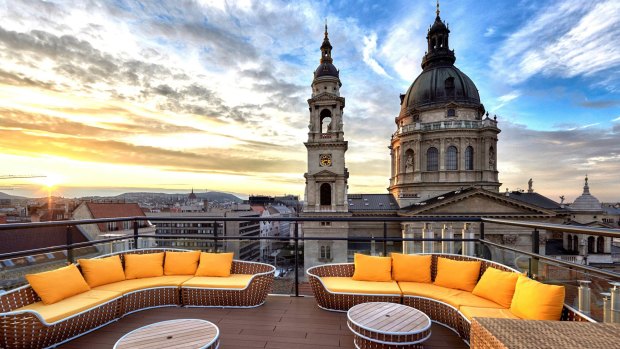
Love Nest at High Note SkyBar at the Aria Hotel in Budapest, Hungary.Credit: Darabos Gyorgy
There is a trick to Origins, and the message it sends. The elver, though, is real. It's alive. I lift up the napkin and pop the sphere in my mouth and chew as the seawater explodes and the eel crunches and my partner and I stare at each other wide-eyed, having reached the zenith of a white-knuckle gastronomic ride.
Nothing will ever be the same. See mugaritz.com
NINA KARNIKOWSKI
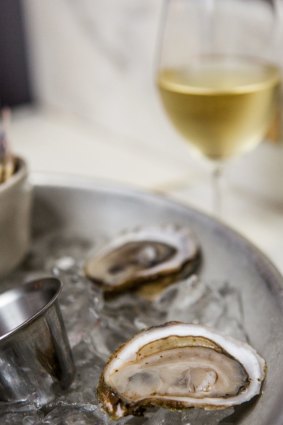
Oysters at the Highlands Bar and Grill in Birmingham, Alabama.Credit: Caleb Chancey Photography
Eight ingredients or less at Uri Buri in Acre, northern Israel
I like to think I know by now that when it comes to food, appearances can be deceiving. But then here I am in the magnificently dilapidated port city of Acre (Akko) in northern Israel, in a seafood restaurant called Uri Buri that I've heard people raving about across the country, looking down at my plate and getting, well, judgy.
A dozen slices of kingfish, swimming in a mix of olive oil, lime and garlic, topped with shaved onion. This, so said the ravers, is supposed to change my life? I look across at my host, chef-owner Uri Jeremias, whose spectacular waist-length white beard is outdone only by his spectacular round belly, and he nods his encouragement. So, I taste and, basically, my mouth explodes.

The Highlands Highlands Bar and Grill in Birmingham, Alabama.Credit: Cary Norton
Here's the thing about Jeremias. He isn't a trained chef, just a guy with a deep love of the ocean and food, who taught himself to cook back in 1989 when he opened this restaurant. The result is the minimalist cooking style that has made Uri Buri such a success, and a menu full of fresh, unpretentious dishes.
There's salmon sashimi sitting simply in soy sauce, topped with a dollop of wasabi gelato, that hasn't left the menu for 20 years. There's an elegant fish soup made with amberjack, coconut milk, curry, lime and ginger, followed by a plate of melt-in-your-mouth anchovies, perfection with a glass of chenin blanc from the nearby Golan Heights region.
"I have two cooking rules," says Jeremias while I stuff my face. "The first is buy the best ingredients, the second is don't spoil them ... I never use more than eight ingredients in any dish."
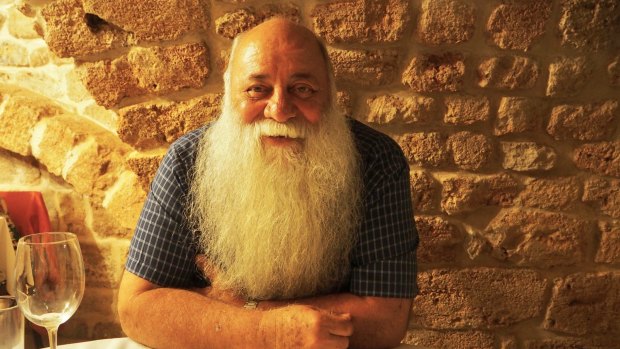
Uri Jeremias at his restaurant in Israel.
And that's it. My whole concept of what defines a good meal, changed forever. Focus on quality produce, work some miracles with olive oil, garlic, chilli and lime, and food will always taste this fantastic. Well, maybe if you live somewhere like Acre, one of the oldest continually inhabited places on Earth, where Jeremias buys his fish direct from the wizened fishermen by the seaside each morning and everything else from the local market, which sources its produce from the abundant small farms this region is known for.
My meal ends with Uri Buri's famous OMG, a trio of orange, mandarin and grapefruit (get it?) sorbets, made from organic fruit from Jeremias' daughter's garden, topped with a splosh of olive oil. It's a sensation.
Luckily, I only have to roll a few hundred metres down the road to the Efendi Boutique Hotel afterwards, an opulent 12-room hotel that merges two restored Ottoman-era palaces, also created and owned by Jeremias. Too full for bed, I head up to the rooftop terrace and, looking out over the crowns of the city's mosques and synagogues to the sea, vow never to let appearances deceive me again. See efendi-hotel.co.il
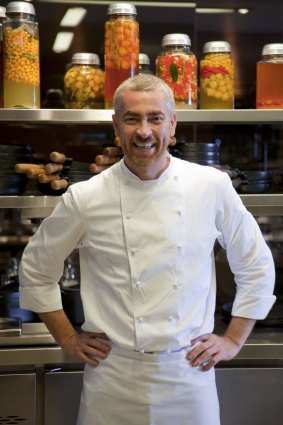
Alex Atala, D.O.M. Sao Paulo, Brazil.
BRIAN JOHNSTON
A nameless neighbourhood trattoria, Sicily
I find the restaurant quite by accident, down a side street near the cathedral. It has no sign – that would attract the attention of Marsala's tax collectors – but the owner is hovering outside. For €8, he says, I can have a set menu, including mineral water and local wine. "And no service charge either," he adds. He's a thin man with a neat moustache and relaxed manner that suggests he doesn't much mind whether I eat here or not.
Eight euros? I shrug off my hesitation when I peer inside and see local businessmen, jackets off and ties loosened, reading pink sports pages and rumbling about politics. The walls are panelled in pine. Chequered tablecloths cover rough trestles.
I'm offered a small plate of antipasti: fat crunchy olives, good salami, dry grana cheese. The olives are the enormous southern-Italian Bella di Cerignola variety, cured in ash and magnificently blue-green. The cheese is hard, with a nutty flavour well matched to the semolina bread from a basket.
"This bread is the best made in town," says the trattoria owner in unexpected English, blushing into his moustache. He pours me a glassful of amber-dark marsala, twisting the neck of the bottle when finished so none of it drips. The fortified wine is a bit sweet but, at this price point, passably pleasant.
After I've polished off the last olive I'm served spaghetti with a strong, rich tomato sauce flecked with pink fingernail-sized prawns hauled out of the sea that morning. The secondi is superb: lightly fried squid in batter, so tender it dissolves in my mouth, and dribbled with fresh lemon juice. My dessert is a mini-cassata decorated with marzipan, icing, lurid quarters of preserved fruit and a glace cherry.
I recall this meal again and again in the decades that follow, after every overhyped Michelin-starred meal and overpriced, Instagram-conscious dish; in every posh restaurant from Barcelona to Bergen. It has been a constant reminder that cheap food can be great food, and that unknown back-alley restaurants can provide lovely dining experiences.
Marsala sits amid red earth and prickly pears on Sicily's sun-beaten western coast. It's a no-nonsense place of baroque buildings and cobwebby wine warehouses bathed in blinding North African light. It has an inconsequential loveliness, and so does my meal. I slump in the heat, in the trattoria's shadows, listening to the kitchen's clatter and inhaling the aromas of tomato sauce and lemon.
This simple meal has forever put Marsala on my mental map. Ever since, I've always sought out bargain local eateries, and mostly been satisfied. Places with no awards, no likes and no hype, but dishing up delight. See visitsicily.info
ROB MCFARLAND
Highlands Bar & Grill, Birmingham, Alabama
Shortly after being seated in Highlands Bar & Grill, our server, Justin, swaps our white napkins for black ones. It's a small gesture, executed wordlessly, but it speaks volumes about the restaurant's attention to detail. The reason for the change? My dining companion and I are both wearing dark outfits and the black napkins are a better match.
Frank Stitt was just 28 years old when he opened Highlands Bar & Grill in 1982 on a rundown street in Birmingham, Alabama. His aim was to utilise the finest local ingredients and apply the cooking techniques he'd learnt in the south of France to his native Southern cuisine.
It's an approach that hasn't wavered in almost four decades. Although the menu changes daily to showcase the best seasonal produce, there are several dishes that are so popular Stitt daren't remove them. One such stalwart is the stone-baked grits, an often-bland Southern staple that's been transformed into a cloud-like pillow of cheesy perfection. Doused in a rich, buttery sauce with wild mushrooms and country ham, it's one of the most divine things I've ever tasted.
The menu is brief – just nine appetisers and eight mains – but Justin's descriptions of each dish are so detailed and evocative, I want to order everything.
The only dinner reservation we can secure is when the restaurant opens at 5.30pm. But already it's brimming with a well-heeled crowd of tourists and locals. The atmosphere is upscale without being formal – think white tablecloths, dark wood panelling and vintage French prints. Contemporary music plays in the background while patrons at a marble-topped bar eat oysters while watching an NFL game on a small TV.
What made this meal life-changing? Well, for a start it was an experience that actually lived up to the hype. Four months before my visit, Highlands was named America's most Outstanding Restaurant in the prestigious James Beard Awards. And this was no fluke – it had already been a finalist nine times. Its pastry chef, Dolester Miles, was named the best in the country, too.
So often these awards are bestowed on pretentious, flash-in-the-pan outfits that are more style over substance. Highlands earned this accolade through hard work and perseverance and by relentlessly obsessing over quality and service. There is something life-affirming about these old-fashioned virtues being rewarded, particularly when they're accompanied by a refreshing dose of humility. When I ask Justin why such a prestigious award isn't mentioned on the menu or alluded to by the staff, he simply replies: "If you don't bring it up, we don't bring it up." See highlandsbarandgrill.com
UTE JUNKER
Breakfast in Iran
Other people might look at the table and see breakfast. I see riches beyond measuring. There are bowls of feta cheese, watermelon, walnuts, and cucumber. There are jams in a profusion of flavours: sour cherry, fig, peach, carrot. There are soft omelettes with fresh tomatoes, and rich lentil soups. And above all, there is bread: large round loaves, flatbread with its edges pleasantly singed, and longer, chewier loaves.
I haven't seen such bounty in months. Before arriving in Iran late last night, I had spent months travelling through the Middle East. I wandered through medieval souks and formidable desert castles, explored Roman ruins and hiked rolling hills. And I have eaten falafel – more falafel than is entirely reasonable. It feels as if every meal I have eaten on this trip has consisted of some combination of falafel, hummus, tabbouleh and pita bread, with skewered meats making an occasional thrilling appearance.
My first Iranian breakfast, simple as it is, announces the truth as unmistakeably as a fanfare of trumpets: last night, I didn't just cross a political border. I also crossed a culinary frontier. No more subsistence dining: things are about to get interesting.
As we criss-cross the country over the next few weeks, every meal brings new revelation: the delights of duck fesanjan, an intoxicating mix of walnut and pomegranate; the tang of gormeh sabzi, a sour, herb-filled stew; and above all else, the just-one-more-spoonful seduction of tahdig, crunchy rice that has deliberately been allowed to crust onto the bottom of the pot. (The only thing better than tahdig is potato tahdig, when sliced potatoes are slipped underneath the rice to create an irresistable carb-laden classic.)
I've eaten delicious food before, of course, and analysed recipes to understand how ingredients work together. But as I eat my way through Iran, for the first time I start think about how every meal you eat comes with an invisible side serve of geography and history.
The diverse landscapes we are travelling across are reflected in things we eat, from the shores of the Caspian Sea, where we feast on smoked fish and the last of the season's caviar, to hilltop hikes where we gaze down on the leafy orchards that supplied the fruit on which we're snacking.
Even the long-vanished Persian empire has left its mark on the country's cuisine. Persia's emperors may have got the glory, but perhaps the most lasting imperial achievement came courtesy of the empire's engineers. They are the ones who created the gravity-assisted irrigation systems that transformed once-arid areas of the country into fertile gardens. That makes the rich flavours of Iranian food – the pistachios and pomegranates, the oranges and mint – the empire's most delicious legacy.
JILL DUPLEIX
Lentil Soup In a medieval ghost town In Abruzzo
The soup was thick with lentils, chickpeas, barley and white beans; a nutty, earthy, wintry soup cooked by two elderly woman in floral aprons, and served in a tough, hollowed-out bread roll. It was winter, 2004, and I was hungry and cold, with shoes soaked through from snow. Every spoonful brought me back to life, infusing me with warmth and strength.
This was my introduction to the medieval town of Santo Stefano di Sessanio, perched high on the panoramic mountain range of Abruzzo's Gran Sasso National Park, an hour and half's drive from the coastal town of Pescara. The solemn little village, with its tall, limestone houses, twisting, cobblestoned alleyways and circular fortress, dates back to the 11th century. Discovering it was like walking through a portal in time.
It was also my introduction to Swedish-Italian architect Daniele Kihlgren and his passion for saving this ancient hilltop town from falling into rubble. Since 2005, Kihlgren's Sextantio foundation has been slowly and painstakingly buying abandoned buildings and restoring them using purely local and regional materials and crafts.
"Italy isn't only the Coliseum, Venice and the Uffizi Gallery" says Kihlgren. "It's a whole distinct world of traditions and sensations that is at risk of disappearing."
It could so easily have been lost to the ravages of time. Once part of an estate belonging to the Medici family, Santo Stefano was a thriving township devoted to the production of carfagna, a coarse wool used for military uniforms and monks' cowls. For thousands of years, shepherds moved their flocks from the mountain pastures down to the wide plains of Apulia in a rhythmic seasonal process known as transhumance. The inevitable march of progress led to the younger generations deserting the village to escape the poverty of rural life, and the population fell from 1500 people at the start of the 20th century, to around 50 today.
Thanks to Kihlgren, you can now stay in the exquisite Palazzo della Loggia, furnished with hand-crafted mattresses, blankets and antiques. You can also dine on lentil soup in the atmospheric Locanda Sotto Gli Archi, where original recipes are recreated using locally grown crops.
This tiny little village, and what it has become, taught me as a traveller to never take for granted the beauty that we find. I am now far more conscious of the commitment and passion that lies behind many of the wondrous sites we visit as tourists. So often, the tradition, the heritage or the natural beauty we seek, only exists because one (usually quite mad, often ridiculed) person is sufficiently obsessed with saving it, protecting it or restoring it. It's fair to say I came home changed, with an overwhelming craving for lentil soup. See sextantio.it
MORE DRINKS AND DISHES – HONOURABLE MENTIONS
VINCISGRASSI, LE MARCHE
You grew up on lasagne – nice, creamy, comfort-food lasagne. Now it's time to go next-level and step up to vincissgrassi ( vin-chiss-grarsy), a proudly regional dish from Italy's mountainous Le Marche region, of pasta layered with creamy calves' brains, chicken livers, wild mushrooms, prosciutto, white wine, and herbs. Once you've had it, you'll look at lasagne and laugh.
CASSOULET, SOUTH-WEST FRANCE
To call cassoulet baked beans and sausages is to call Dom Perignon a nice little bubbly. This is the king of all stews, a hearty, rustic and yet sophisticated baked dish from the south-west of France that brings together white beans, sausage, and pork with duck or goose confit under a golden crust of breadcrumbs. Pass the red wine, please.
SHOYU RAMEN, JAPAN
This is Tokyo's classic ramen-noodle dish, a soup made from chicken bones or dried fish, seasoned with soy sauce and then added to chewy noodles, fermented bamboo shoots, and a marinated boiled egg – sensational.
TXULETA, SPAIN
It doesn't get much more simple or delicious than this: a bone-in rib-eye steak, cut as thick as your arm, doused with salt and then seared until it's barely rare over open fire at an "asador" high in Spain's Basque Country.
BANH MI, HOI AN, VIETNAM
This might just be the world's best sandwich, a short, French-style bread roll smeared with pate and butter and filled with various pork products, pickled vegetables, fresh herbs, and a secret chilli sauce that is the stuff of instant addiction.
THALI, INDIA
Is there a greater joy than being able to dig into your food with your hands, to mixing up curries with rice, to scooping it up with bread, to adding chutneys, to crackling pappadums, to doing all this with the simplest eating tools imaginable? Surely not.
SOLE MEUNIERE, FRANCE
One of the often-unsung heroes of French cuisine, sole meuniere has an otherworldly greatness, the delicate meat of the fish perfectly balanced by the richness of lightly browned butter with lemon and parsley.
SCHNITZEL IN VIENNA
This dish might be considered a greasy pub filler, but the real deal has a succulent veal interior, crunchy coating and accompaniment of potato or cucumber salad that raises it to a simple but elegant meal fit for an emperor. See wien.info
NISHIMURAYA HONKAN, JAPAN
The winter snow-crab season in venerable hot-spring town Kinosaki Onsen is a must for gourmets. Stay at this ryokan and your kaiseki meal might include crab sashimi style, boiled, grilled and in a hotpot. See nishimuraya.ne.jp
MORE RESTAURANTS AND BARS – HONOURABLE MENTIONS
THE AMERICAN BAR, THE SAVOY HOTEL, LONDON
With its white-jacketed mixologists, black-and-white Chanel colour scheme and warm and clubby atmosphere, this is a bar – at nearly 130 years old, the oldest in London – in which you could move in and live on cocktails all year round. And as its legendary bartender, Harry Craddock, said in the 1930s, cocktails are "the finest appetisers around". thesavoylondon.com
BAR DESY, SAN SEBASTIAN, SPAIN
This is the local bar of your dreams, a plain, unfashionable little joint in the San Sebastian suburbs where the food is excellent, the craft beer is top-notch and the welcome from the father-son team of Jose and Gorka Perez makes you feel instantly like part of the family.
UOSHIN, TOKYO, JAPAN
There's nothing fancy about Uoshin, a seafood izakaya in Tokyo's Ebisu neighbourhood – but that's its attraction, the perfect demonstration of just how relaxed and enjoyable and yet incredibly tasty a Tokyo bar can be. See uoshins.com
ASADOR ETXEBARRI, AXPE, SPAIN
This Basque restaurant is no secret – it's currently No. 3 on the World's 50 Best Restaurants list – but it's well worth the trouble to secure a booking: the food here, each dish grilled over hot coals, and yet cooked with surprising delicacy and finesse, is cuisine at its absolute pinnacle. See asadoretxebarri.com
HARWOOD ARMS, LONDON, ENGLAND
England has extremely good food: allow that to sink in as you sit at the Harwood Arms, a "gastro-pub" in west London, and enjoy traditional fare that has been given a gentle nudge into greatness, expertly handled and perfectly presented. See harwoodarms.com
CORIANDER LEAF, SINGAPORE
Odd fusion cuisines are usually better for shock value than flavour, but this modest, mid-range restaurant proves otherwise. Pan-Asian influences range from Turkey and Iran through to India, Korea and Japan, and every dish is sensational. See corianderleaf.com
HIGH NOTE SKYBAR, ARIA HOTEL, BUDAPEST
Voted No. 1 hotel in the world by TripAdvisor in 2017, this gorgeous music-themed property's crowning glory is a stunning rooftop bar with gasp-inducing views of the city and St Stephen's Basilica. See highnoteskybar.hu
CONNIE, TWA HOTEL, NEW YORK
The standout feature of JFK's new TWA Hotel is Connie, an intimate '60s-themed cocktail bar located in a refurbished 1958 TWA Lockheed Constellation Starliner. See twahotel.com
TROISGROS, FRANCE
France's first family of food has held three Michelin stars for more than 50 years, but everything about their restaurant, from the conceptual design to the fresh flavours on the plate, is ultra-contemporary. troisgros.com
DIRT CANDY, NEW YORK
Three cheers for chef Amanda Cohen. In addition to launching New York's first vegie-based restaurant 12 years ago, she has abolished tips and curated a wine list consisting exclusively of female winemakers. See dirtcandynyc.com/
D.O.M., SAO PAULO
Long before everyone was a locavore, Brazilian chef Alex Atala's showcased Amazonian ingredients – from heart of palm to ants – in ambitious degustation dinners at his Sao Paulo restaurant. See domrestaurante.com.br
LE COMPTOIR, PARIS
It's the bistro of your dreams, as you sit inside or out on the street, elbow-to-elbow, with platters of terrines and cheeses by day, and an adventurous set menu at night. Former fine dining chef, Yves Camdeborde, is the poster boy for France's "bistronomy", with an aim to make traditional bistro cooking relevant to today. See hotel-paris-relais-saint-germain.com
SWAN OYSTER DEPOT, SAN FRANCISCO
For the past 74 years, three generations of the Sancimino family have been behind the marble counter of this gussied-up seafood diner, serving up local oysters and cracked Dungeness crab with sauce Louis, Anchor Steam beer and wise-guy humour. The counter, however, is short, and the queue is long. Visit 1517 Polk Street, San Francisco.
THE LONG BAR, RAFFLES, SINGAPORE
The Long Bar does what a bar should do ... transport you to another place. With its rattan ceiling fans and potted palms, this is a glimpse of old colonial Singapore. The Singapore Sling cocktail, first created here in 1915, is no longer as sweet as it was ( a good thing), but you're really here for the illicit pleasure of cracking open peanuts and strewing the shells on the floor. See raffles.com
Sign up for the Traveller Deals newsletter
Get exclusive travel deals delivered straight to your inbox. Sign up now.